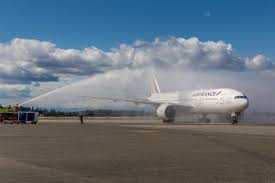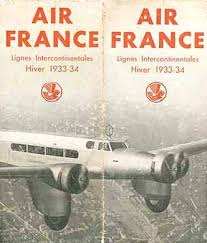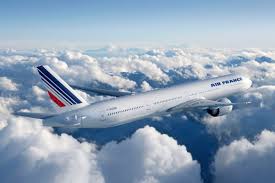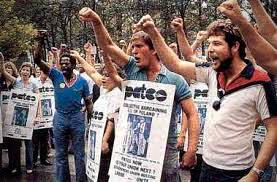AIR CARRIERS & CRAFT. Air France: French Fried? + Labor Woes…📌
Air Carriers & Craft (Premise).
Strike a fatal blow to Société Air France? According to Finance Minister, Bruno Le Maire it is, and AF-KLM  Chief Executive Jean-Marc Janaillac has packed it in to press his point. They maintain the French flag carrier’s survival is ‘in the balance’ now that its pilots union has rejected management’s 7% over five years offer, holding firm to labor’s straight up 5.1% pay raise demand.
Chief Executive Jean-Marc Janaillac has packed it in to press his point. They maintain the French flag carrier’s survival is ‘in the balance’ now that its pilots union has rejected management’s 7% over five years offer, holding firm to labor’s straight up 5.1% pay raise demand.
Meanwhile, the airline, in operation since 1933, claims it lost over €300m since the walk-out began some two weeks ago, and seen its share price drop 10-14% (40% year to date). Yet through it all, AF says, it has continued with 87% of its short-haul flights, 99% of its international schedule—to 36 domestic destinations (out of its Charles de Gaulle Airport hub) and some 168 worldwide—via its fleet of Airbus and Boeing aircraft. 
The strike today represents employee resistance to some stringent restructuring plans initiated by the French government, which happens to own a 14.3% stake in Europe’s second largest airline—most recently by virtue of current President Emmanuel Macron’s program of carrier belt tightening and austerity throughout France (SNCF Railway included). This, after seven years of back-to-back Air France losses and a €269m deficit in Q1 2018 alone.
AF-KLM (Royal Dutch), a joint company since 2004, was profitable in 2016, however, amid a favorable environment of lower fuel prices and a travel/tourism uptick overall, albeit with operating costs at 94% of revenue. Staff productivity rose 2.3% (AF), 4.2% (KLM) in 2016, then up 3.7% and 2.9% respectively in 2017. Indeed, KLM itself is profitable, and Air France has even recently launched low-cost local ‘Transavia’ and premium, longer-haul boutique spin-off named ‘Joon’.
Thus government demands that the carrier become more cost-conscious and competitive, that the pilots union pay raise demands are ‘unjustified’, do rather ring hollow—as a 5.1% bump now would hardly dent a reported 2017 net income topping €1b, and they no longer want the shirts off management’s backs. Still, Macron’s administration now faces either a fuller Alitalia-style bailout, or bailing on AF-KLM altogether and/or selling off assets.
To be sure, flag airlines such as Air France are increasingly profit squeezed by lower-cost carriers like RyanAir and EasyJet regionally, and heavily subsidized Middle East lines over the longer haul—particularly not when fuel prices rise anew. RyanAir, by comparison, trims operating costs to 73% of last year’s revenue, so can absorb a unionized pilot pay increase of 20%. Yet Germany’s Lufthansa flagship can increase its pilots’ pay 10.3% over five years, ground employees up 6%, and still report solid profit margins.
But the resulting downward pressure on ticket prices through added low fare capacity is only part of the picture. For airlines have long been pushing more reductive staffing strategies, not least zero-hour or on-call contracts for pilots and crews, repelling top flying talent, sapping morale.
 Comes a point where labor battles such as Air France’s—the short-sighted penny pinching and low balling can only adversely impact airline quality—if not tarmac, runway and inflight safety for the traveling public.
Comes a point where labor battles such as Air France’s—the short-sighted penny pinching and low balling can only adversely impact airline quality—if not tarmac, runway and inflight safety for the traveling public.
And even though AF’s pilots union may ostensibly be standing down for the moment (amid softening popular support perhaps?), these crippling strikes and tight-fisted management counter actions make for a very troubling formula: bad attitudes=bad altitudes, time and time again.
As for Ireland’s RyanAir, its hard bottom line business plan has now resulted in a series of pilot strikes over pay and conditions that are crippling Europe’s largest low-fare carrier with each work stoppage. Today, a 24-hour walk-out (the largest so far) coordinated across five European countries has forced RyanAir to cancel one-sixth of its flights. This after a July action by cabin crews similarly forced the scratching of 300 flights for 48 hours in Belgium, Portugal and Spain—not long after the airline agreed to recognize its employees’ union and enter collective bargaining after long refusing to do so. The pilots further demand that their contracts be negotiated according to broader EU laws, rather than Irish legislation. This, while carrier shareholders protest the management of chairman David Bronderman.
Affected passengers were merely notified by last-minute e-mails, and re-routed to other flights, however inconvenient and plan disruptive. Their only apparent redress must be pursued either through the carrier and/or EU compensation rules, as RyanAir claims an ‘extraordinary circumstances’ exemption (due to the pilots’ “unjustified action”). So it remains to be seen how long it will take for any requital is forthcoming, if at all. One thing is clear, however, with cockpit crew shortages rampant throughout the airline industry these days, these striking pilots are increasingly in the driver’s seat. And RyanAir’s work stoppages threaten to keep on coming. Meanwhile its passengers turn on one another under cramped cabin conditions, as in the British man’s racist rant against an elderly black row mate on the tarmac in Barcelona.
![]() 2019’s Summery Labor Pains.
2019’s Summery Labor Pains.
Back in the U.S., American Airlines battles the International Association of Machinists (IAM) and Transport Workers Union (TWU) over the carrier’s plans to outsource aircraft maintenance to to South America. Union leaders claim A/A seeks to fly around stateside FAA-licensed jet mechanics, essentially busting the trade unions and compromising airline safety. So a peak season carrier-wide strike action may be in the offing. Already, caterers unions are threatening a walk-out at SFO for better wages and health care—although theoretically, such a strike would need approval from the National Mediation Board. So it’s wait and see as the high season begins…
At the same time, all major carriers are looking down the taxiway to possible labor stoppage by ground workers, particularly catering employees—near minimum wage food suppliers who supply onboard galleys with meals, snacks and beverages for flight attendant distribution cabin wide. Most caterers, as well as other airline workers fall under the Railway Labor Act, which means they cannot strike without permission from the National Mediation Board (rarely granted, because of potential impact on interstate commerce).
But that doesn’t preclude these workers from de facto affecting the quality of inflight service. Now whether they choose to go that pressure point route remains to be seen, especially with the Reagan-era air traffic controllers strike and ensuing furlough massacre still haunting airport terminals and towers. ☟
So we Vamigrés strike a blow for travel safety and service—particularly amid an acute, abiding pilot shortage overall. Exacerbated by a flood of aviators reaching mandatory retirement age, many carriers are rushing commuter airline partner pilots into the cockpits of longer-range 757 and 767 jets. Reasons enough why Vamigré will be diligently scanning the stormy skies and alertly standing our ground…
+VamoSez: Cubana Aero and aging planes:
+ Is Southwest Heading Southward?
Air Carriers & Craft (Premise).
☟ Rearview Mirror: ’81 PATCO Putdown.
![]() Any labor reticence on strike actions arguably stems from the PATCO pummeling of 1981. To refresh…
Any labor reticence on strike actions arguably stems from the PATCO pummeling of 1981. To refresh…
At the time, air traffic controllers collectively felt overworked on outdated tower equipment and conditions. They complained of the stress of issuing life or death decisions nonstop, while logging minutely explicit flight data and taking/making phone calls on some 40 lines. The ATCs wanted to be treated as essential professionals, equal to the pilots they directed. So the Professional Air Traffic Controllers Organization (PATCO) union leaders calculated that since its members had a virtual lock on the domestic U.S. market for their specialized skills, 100% participation in a walkout would shut down air traffic nationally, if not worldwide.
Goal being: such a work stoppage would be quite the cudgel to the D.O.T. meeting of their demands for reduced shift hours, better tower technology, and an earlier, fatter retirement package: basically as a negotiation tactic. Really, what could a fledgling  White House administration do about it but cave in, mantra being: ‘They can’t fire us all’.
White House administration do about it but cave in, mantra being: ‘They can’t fire us all’.
Instead, President Ronald Reagan took the PATCO action as a personal challenge to his newfound authority. Invoking the Taft-Hartley rule forbidding all federal employees from striking, Reagan with his Transportation and Justice Department summarily canned 11,345 absent controllers barely three days into PATCO’s stoppage.
From there, it was the federal monopoly on towers versus the presumed monopoly on certified ATC skills. Thus his administration banned them from federal employment for life, calling them arrogant lawbreakers. Then he hired FAA brass, military aviation types, quickie controller trainees and various scabs to staff the towers (only 1,200 strikers knuckled and returned to their posts). Meanwhile the NLRB determined controllers had the right to strike, but the government had the right to bring in replacements.
Union Down For the Count.
Soon rumors spread of airliner near misses and schedule disruptions; confidence was waning in the safety of domestic skies. The strike crippled air traffic globally, disrupting millions of travelers per day. And an inconvenienced flying public didn’t exactly rally around the picketing controllers’ cause, rather blaming PATCO for it all. With little or no AFL/CIO or international ATC support, the striking controllers found themselves flying solo on this power trip of theirs.
Reagan’s strikebreakers eventually secured those permanent tower slots, as they proved up to the scramble and safety challenge—no crashes nor incidents of consequence in the months to come, despite operating with reduced staffing levels. The scabs were also rewarded with many of the improvements union strikers demanded in the first place.
Meanwhile, PATCO stalwarts continued walking the airport picket lines for weeks in vain, learning the hard lesson that nobody, not even a proud, expert air traffic controller, was indispensable—much less galley caterers and ramp rats.
The Reagan administration got full PATCO decertification on October 22, 1981, and that union never did pull out of its death spiral.
So Vamigré will be watching to see if such labor pains haven’t changed to this very day…
